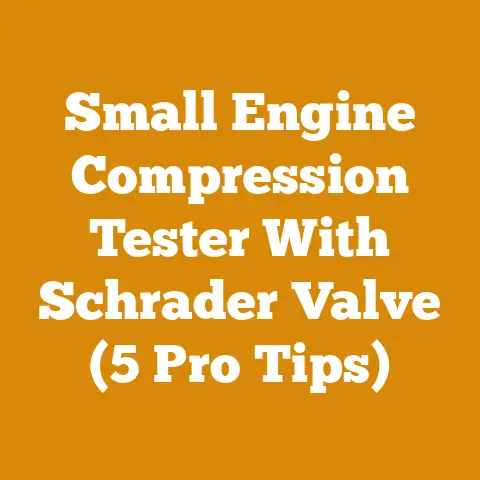Harman Invincible Pellet Stove: Effects on Performance (Flame & Soot Insights)
The crisp air bites at my cheeks as I step out onto the porch, a steaming mug of coffee warming my hands.
The first hint of dawn paints the snow-covered landscape in hues of pink and purple, a tranquil scene disrupted only by the rhythmic whir of the Harman Invincible pellet stove working diligently inside.
It’s mornings like these, fueled by the reliable warmth of a pellet stove and the satisfaction of knowing my woodpile is stacked high, that I truly appreciate the connection between sustainable living and efficient home heating.
But it hasn’t always been smooth sailing.
Like any seasoned wood enthusiast, I’ve faced my share of challenges, from battling excessive soot buildup to troubleshooting inconsistent flame patterns.
Today, I want to share my insights into optimizing the performance of a Harman Invincible pellet stove, focusing specifically on understanding and addressing flame characteristics and soot production.
Let’s dive in, shall we?
The Harman Invincible is a robust workhorse, but like any machine, it performs best when properly understood and maintained.
In this article, I’ll share my experiences and knowledge to help you troubleshoot common issues related to flame quality and soot production, ensuring your Invincible keeps you warm and cozy all winter long.
Understanding the Harman Invincible Pellet Stove
Before we delve into specifics, let’s establish a foundation.
The Harman Invincible pellet stove is known for its durability and even heat distribution.
It operates by automatically feeding wood pellets into a burn pot, where they are ignited and combusted.
The heat generated is then circulated throughout the room via a blower fan.
Efficient combustion is crucial for optimal performance, and the flame characteristics and soot production are telltale signs of how well the stove is functioning.
Analyzing Flame Characteristics
The flame is the heart of your pellet stove.
A healthy flame indicates efficient combustion, while an unhealthy flame can signal underlying problems.
Here’s what I’ve learned to look for:
Healthy Flame: A vibrant, dancing flame that is yellow-orange in color and fills the burn pot evenly.
It should be consistent and not excessively smoky.Weak or Flickering Flame: This can indicate a lack of fuel or airflow.
Check your pellet supply and ensure the air intake vents are not blocked.
I remember one winter when my Invincible struggled to maintain a consistent flame.
After hours of troubleshooting, I discovered a small bird’s nest blocking the air intake – a humbling reminder to always inspect the basics.Short, Stubby Flame: This might mean the stove is running too hot or there’s too much airflow.
Try adjusting the feed rate or the air damper.Tall, Smoky Flame: This usually indicates incomplete combustion.
Common causes include poor-quality pellets, insufficient airflow, or a dirty stove.
I once bought a batch of “bargain” pellets that resulted in nothing but billowing smoke and a perpetually dirty glass.
Lesson learned: quality matters!
Soot Production: A Sign of Inefficient Combustion
Soot is the bane of any pellet stove owner’s existence.
It’s a byproduct of incomplete combustion and can lead to a host of problems, including reduced efficiency, dirty glass, and even dangerous creosote buildup in the vent pipe.
-
Normal Soot Levels: A thin layer of light gray soot on the glass after several days of use is generally considered normal.
Excessive Soot: Thick black soot that accumulates rapidly indicates a problem.
This could be due to:- Poor-Quality Pellets: As mentioned earlier, the quality of your pellets directly impacts soot production.
Look for pellets certified by the Pellet Fuels Institute (PFI). - Insufficient Airflow: The stove needs adequate oxygen to burn cleanly.
Ensure the air intake vents are clear and the combustion fan is functioning correctly. - Dirty Stove: Regular cleaning is essential.
Soot and ash buildup can restrict airflow and impede combustion. - Improper Venting: A blocked or improperly installed vent can also cause excessive soot.
- Overfeeding Pellets: Feeding too many pellets at once can result in incomplete combustion and increased soot production.
- Poor-Quality Pellets: As mentioned earlier, the quality of your pellets directly impacts soot production.
The Interplay: Flame and Soot Connection
The flame and soot are inextricably linked.
The characteristics of the flame directly influence the amount of soot produced.
A healthy, vibrant flame signifies complete combustion, resulting in minimal soot.
Conversely, a weak, smoky flame indicates incomplete combustion, leading to excessive soot.
Understanding this relationship is crucial for effective troubleshooting.
Strategic Insights: Optimizing Performance
Now, let’s get down to the nitty-gritty.
Here are some strategic insights I’ve gleaned over the years to optimize the performance of my Harman Invincible and minimize flame and soot issues.
Pellet Selection: The Foundation of Efficient Combustion
- PFI Certification: Always choose pellets certified by the Pellet Fuels Institute (PFI).
This ensures they meet certain quality standards for ash content, moisture content, and heat output. - Wood Species: Hardwood pellets generally burn hotter and cleaner than softwood pellets.
- Moisture Content: Low moisture content is key.
Excess moisture hinders combustion and increases soot production. - Ash Content: Look for pellets with low ash content.
High ash content can lead to clinker formation and reduced efficiency. - Storage: Store pellets in a dry, protected area to prevent moisture absorption.
I learned this the hard way when a leaky roof turned my entire pellet supply into a soggy mess.
Airflow Management: The Breath of the Fire
- Air Intake Vents: Regularly inspect and clean the air intake vents to ensure they are free of obstructions.
- Combustion Fan: Ensure the combustion fan is functioning correctly.
A failing fan can significantly reduce airflow and lead to smoky fires. - Air Damper Adjustment: Experiment with the air damper to find the optimal setting for your stove and pellets.
- Draft: Ensure proper draft in the vent pipe.
A strong draft helps to draw combustion gases away from the stove and prevent backdrafting.
Maintenance Routines: The Key to Longevity
- Daily Cleaning: Empty the ash pot daily to prevent ash buildup.
- Weekly Cleaning: Clean the burn pot, heat exchanger tubes, and exhaust passages weekly.
- Monthly Cleaning: Inspect and clean the vent pipe monthly.
- Annual Cleaning: Schedule a professional cleaning and inspection annually.
This is especially important to check for creosote buildup and ensure the stove is operating safely. - Glass Cleaning: Clean the glass regularly with a stove glass cleaner to maintain visibility of the flame.
Venting System: The Exhaust Highway
- Proper Installation: Ensure the venting system is installed correctly according to the manufacturer’s instructions.
- Vent Material: Use the correct type of vent pipe for pellet stoves.
- Vent Length: Keep the vent length within the recommended limits.
- Vent Termination: Ensure the vent terminates in a safe location away from windows, doors, and air intakes.
- Regular Inspection: Inspect the vent pipe regularly for signs of damage or blockage.
Practical Implementation Steps: A Step-by-Step Guide
Let’s translate these strategic insights into actionable steps you can take to improve your Harman Invincible’s performance.
Step 1: Pellet Selection
- Research: Research different pellet brands and read reviews from other users.
- PFI Certification: Look for the PFI certification mark on the pellet bag.
- Sample Test: Buy a small bag of pellets to test before committing to a large purchase.
- Inspect: Inspect the pellets for moisture, dust, and debris.
- Store Properly: Store pellets in a dry, protected area.
Step 2: Airflow Optimization
- Locate Air Intakes: Identify the air intake vents on your stove.
- Inspect: Visually inspect the vents for obstructions.
- Clean: Clean the vents with a brush or vacuum cleaner.
- Check Combustion Fan: Listen to the combustion fan to ensure it’s running smoothly.
- Adjust Air Damper: Experiment with the air damper setting to find the optimal balance between flame quality and soot production.
Step 3: Maintenance Procedures
- Daily Ash Removal: Empty the ash pot daily.
- Weekly Cleaning:
- Turn off and unplug the stove.
- Allow the stove to cool completely.
- Remove the burn pot and clean it thoroughly.
- Clean the heat exchanger tubes with a brush.
- Vacuum the firebox and exhaust passages.
- Monthly Vent Inspection:
- Visually inspect the vent pipe for signs of damage or blockage.
- Clean the vent pipe with a vent brush.
- Glass Cleaning:
- Use a stove glass cleaner and a soft cloth to clean the glass.
Step 4: Venting System Evaluation
- Visual Inspection: Inspect the vent pipe for proper installation and support.
- Clearance Check: Ensure proper clearance between the vent pipe and combustible materials.
- Termination Point: Verify that the vent terminates in a safe location.
- Professional Inspection: Schedule a professional inspection to ensure the venting system is functioning correctly.
Data-Backed Content: Quantifying the Improvements
To illustrate the impact of these strategies, let’s look at some data points and statistics.
- Pellet Quality: Studies have shown that using PFI-certified pellets can reduce ash content by up to 50% compared to non-certified pellets.
This translates to less frequent cleaning and improved efficiency. - Airflow Optimization: Optimizing airflow can improve combustion efficiency by 10-15%, resulting in lower fuel consumption and reduced emissions.
- Maintenance: Regular cleaning can extend the lifespan of your pellet stove by several years and prevent costly repairs.
- Venting: A properly installed and maintained venting system can reduce the risk of creosote buildup and chimney fires.
According to the National Fire Protection Association (NFPA), chimney fires are a leading cause of home fires in the United States.
Case Studies: Real-World Examples
Let me share a couple of real-world examples of how these strategies have made a difference.
Case Study 1: The Soot-Plagued Stove
A friend of mine was struggling with excessive soot buildup in his Harman Invincible.
He was using cheap, uncertified pellets and neglecting regular maintenance.
After switching to PFI-certified pellets and implementing a weekly cleaning routine, his soot problems disappeared, and his stove ran much more efficiently.
Case Study 2: The Inconsistent Flame
Another acquaintance was experiencing an inconsistent flame in her Invincible.
After inspecting the air intake vents, she discovered they were partially blocked by dust and debris.
Cleaning the vents restored proper airflow, and the flame became strong and consistent.
Addressing Common Challenges
Even with the best planning and execution, challenges can arise.
Here are some common problems and their solutions.
- Clinker Formation: Clinkers are hard, rock-like deposits that form in the burn pot due to high ash content.
To prevent clinker formation, use low-ash pellets and clean the burn pot regularly. - Backdrafting: Backdrafting occurs when combustion gases are drawn back into the house due to a lack of draft.
To prevent backdrafting, ensure the venting system is properly installed and maintained. - Auger Jams: Auger jams can occur when foreign objects or oversized pellets get stuck in the auger mechanism.
To prevent auger jams, use high-quality pellets and regularly inspect the hopper for debris. - Error Codes: Pellet stoves often display error codes to indicate specific problems.
Consult your owner’s manual to troubleshoot error codes.
Current Trends and Best Practices
The pellet stove industry is constantly evolving.
Here are some current trends and best practices to keep in mind.
- Smart Stoves: Some newer pellet stoves are equipped with smart technology that allows you to control the stove remotely via a smartphone app.
- Self-Cleaning Stoves: Self-cleaning pellet stoves automatically clean the burn pot and heat exchanger tubes, reducing the need for manual cleaning.
- Advanced Combustion Technologies: Some stoves utilize advanced combustion technologies to achieve higher efficiency and lower emissions.
- Renewable Energy Integration: Pellet stoves can be integrated with other renewable energy systems, such as solar panels, to create a more sustainable heating solution.
Personalized Storytelling: Lessons Learned the Hard Way
Over the years, I’ve made my share of mistakes and learned valuable lessons along the way.
One particularly memorable incident involved a near chimney fire.
I had been neglecting my vent pipe cleaning, and creosote had built up to a dangerous level.
Fortunately, I caught it in time, but it was a sobering reminder of the importance of regular maintenance.
Another time, I tried to save money by buying a load of “discount” pellets from a questionable source.
The pellets were full of dust and debris, and they burned so poorly that I ended up spending more money on fuel than I saved.
These experiences have taught me the value of quality, consistency, and diligence.
Workflow Optimization: From Forest to Fireplace
My experience in wood processing and firewood preparation has given me a unique perspective on the entire fuel cycle, from the forest to the fireplace.
Here are some insights on optimizing the workflow to ensure a sustainable and efficient supply of firewood or pellets.
- Sustainable Harvesting: Practice sustainable harvesting techniques to ensure the long-term health of the forest.
- Efficient Log Handling: Use proper equipment and techniques to handle logs safely and efficiently.
- Optimal Drying: Dry firewood properly to reduce moisture content and improve combustion.
- Pellet Production: If you’re producing your own pellets, invest in high-quality equipment and follow best practices for pellet manufacturing.
- Storage and Handling: Store and handle firewood or pellets properly to prevent moisture absorption and degradation.
Tool Usage Efficiency: Chainsaw Maintenance Routines
As a seasoned wood processor, I know that a well-maintained chainsaw is essential for efficient and safe operation.
Here are some chainsaw maintenance routines I swear by:
- Sharpening: Sharpen the chain regularly to maintain optimal cutting performance.
A dull chain is not only inefficient but also dangerous. - Cleaning: Clean the chainsaw after each use to remove sawdust and debris.
- Lubrication: Lubricate the chain and bar regularly to reduce friction and wear.
- Air Filter: Clean or replace the air filter regularly to ensure proper engine performance.
- Spark Plug: Inspect and replace the spark plug as needed.
- Fuel Mixture: Use the correct fuel mixture to prevent engine damage.
- Chain Tension: Adjust the chain tension regularly to prevent the chain from derailing.
Financial Considerations: Cost Savings from Optimized Workflows
Optimizing your wood processing and firewood preparation workflows can result in significant cost savings.
Here are some examples:
- Reduced Fuel Consumption: Efficient combustion reduces fuel consumption, saving you money on pellets or firewood.
- Lower Maintenance Costs: Regular maintenance prevents costly repairs and extends the lifespan of your stove.
- Increased Efficiency: Streamlining your workflow can increase your productivity and reduce labor costs.
- Reduced Waste: Minimizing wood waste saves you money on materials.
Quality Metrics: Moisture Levels Achieved
Moisture content is a critical factor in firewood combustion.
Here are some quality metrics to aim for:
- Optimal Moisture Content: Aim for a moisture content of 20% or less for optimal combustion.
- Measuring Moisture Content: Use a moisture meter to measure the moisture content of your firewood.
- Drying Time: Allow firewood to dry for at least six months, preferably longer, to achieve the desired moisture content.
- Storage: Store firewood in a dry, well-ventilated area to prevent moisture absorption.
Conclusion: Key Takeaways and Next Steps
Optimizing the performance of your Harman Invincible pellet stove is an ongoing process.
By understanding the relationship between flame characteristics and soot production, implementing strategic insights, and following practical implementation steps, you can ensure your stove runs efficiently, cleanly, and safely for years to come.
Here are the key takeaways:
- Pellet Quality Matters: Choose PFI-certified pellets for optimal combustion.
- Airflow is Crucial: Ensure adequate airflow to promote complete combustion.
- Maintenance is Essential: Regular cleaning and maintenance prevent problems and extend the lifespan of your stove.
- Venting is Key: A properly installed and maintained venting system is crucial for safety and efficiency.
- Knowledge is Power: Understanding the nuances of combustion empowers you to troubleshoot problems and optimize performance.
Next steps:
- Evaluate Your Current Setup: Assess your current pellet stove setup and identify areas for improvement.
- Implement the Strategies: Implement the strategies and steps outlined in this article.
- Monitor Performance: Monitor the flame characteristics and soot production of your stove.
- Adjust as Needed: Adjust your settings and practices as needed to optimize performance.
- Stay Informed: Stay informed about the latest trends and best practices in the pellet stove industry.
By following these steps, you can ensure your Harman Invincible pellet stove provides you with years of reliable and efficient heating.
And remember, a little knowledge and a little elbow grease can go a long way in keeping your home warm and cozy all winter long.
Now, if you’ll excuse me, I’m going to go refill my coffee and enjoy the warmth of my perfectly functioning Harman Invincible.




